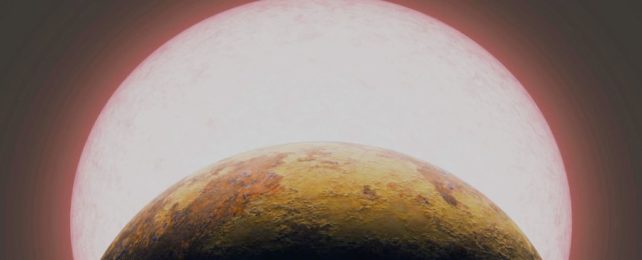A newly found exoplanet just 200 light-years away could shed new light on one of planetary science's strangest mysteries.
At around 1.8 times the radius of Earth, the object named TOI-1075b ranks among the biggest examples of a super-Earth exoplanet we've found to date. It also sits solidly in what we call the small-planet radius gap; a seeming deficit of planets between 1.5 and 2 Earth radii.
Slightly smaller rocky super-Earths have been found. So have slightly larger worlds bulked up with puffy atmospheres, known as mini-Neptunes. But in between, it's something of a desert.
That added girth isn't all puff, either. TOI-1075b's mass is 9.95 times that of Earth's. That's way too hefty for a gaseous world; at the inferred density, the exoplanet is likely to be rocky, like Mercury, Earth, Mars, and Venus. This peculiarity makes it an ideal candidate for probing theories of planetary formation and evolution.
The small-planet radius gap was only identified a few years ago, in 2017, when we had a large enough catalog of exoplanets (extrasolar planets, or planets outside the Solar System) for scientists to notice a pattern. For exoplanets within a certain close proximity of their stars, very few worlds have been found that straddle that gap.
There are several possible explanations for this; the leading one seems to be that, below a certain size, an exoplanet simply doesn't have the mass to retain an atmosphere against the evaporative radiation so close to the host star. According to this model, exoplanets in the gap should therefore have a pretty sizable atmosphere consisting primarily of hydrogen and helium.
Enter TOI-1075b. It was detected in data from NASA's exoplanet-hunting telescope, TESS. Short for Transiting Exoplanet Survey Satellite, TESS looks for faint, regular dips in the light of other stars suggesting these stars are being orbited by an exoplanet. Astronomers can also tell the radius of that exoplanet based on how much of the star's light is being dimmed.
The TESS data suggested that the orange dwarf star TOI-1075 was being orbited by an exoplanet around 1.72 times the radius of Earth, on an orbital period of about 14.5 hours. This got the attention of astronomer Zahra Essack of MIT, who is studying hot super-Earths. At that radius and proximity, the then-candidate world fit the criteria for a radius-gap world.
The next step to try to understand the nature of this exoplanet was to weigh it. This involves leveraging a different effect an exoplanet has on its host star: gravitational. Most of the gravity in a star-planet interaction is supplied by the star, but the planet exerts a tiny gravitational tug back on the star, too. That means a star wobbles very slightly on the spot, and astronomers can detect this in tiny changes in the star's light.
If we know the mass of the star, those changes can be used to gauge the mass of the planet jiggling the star. TOI-1075 has a mass and radius about 60 percent of that of our own Sun, so Essack and her colleagues were able to precisely calculate the exoplanet's mass to 9.95 Earth masses. And their precision measurements of the size returned 1.791 Earth radii.
If you know how big something is, and how heavy it is, you can then calculate its average density. And TOI-1075b? Turned out to be an absolute chonk. It has a density of 9.32 grams per cubic centimeter. That's nearly twice Earth's density of 5.51 grams per cubic centimeter, making it a contender for the densest super-Earth on the books.
An exoplanet in the mass gap should have a substantial hydrogen-helium atmosphere. TOI-1075b's density is inconsistent with a substantial atmosphere. This is very curious. But what the exoplanet could have instead is potentially even more fascinating.
"Based on TOI-1075b's predicted composition and ultra-short orbital period, we do not expect the planet to have retained a H/He envelope," the researchers write in their paper.
"But, TOI-1075b could either have: no atmosphere (bare rock); a metal/silicate vapor atmosphere with a composition set by the vaporizing magma-ocean on the surface since TOI-1075 b's equilibrium temperature is hot enough to melt a rocky surface; or, especially at the low-end of its allowed mean density range, possibly a thin H/He or CO2 or other atmosphere."
Yep, you read that right. TOI-1075b is so hot (from being so close to its star) that its surface could be an ocean of magma that produces an atmosphere of vaporized rock.
The good news here is that we might find out. As we've only recently seen, JWST is powerfully adept at peering into the atmospheres of exoplanets. Pointing it at TOI-1075b should reveal if it has a thin atmosphere, a silicate atmosphere, or no atmosphere at all – and this information could reveal some previously unknown quirk of planet formation and evolution, and how super-Earths lose their gas.
The team's research has been accepted in The Astronomical Journal, and is available on arXiv.
